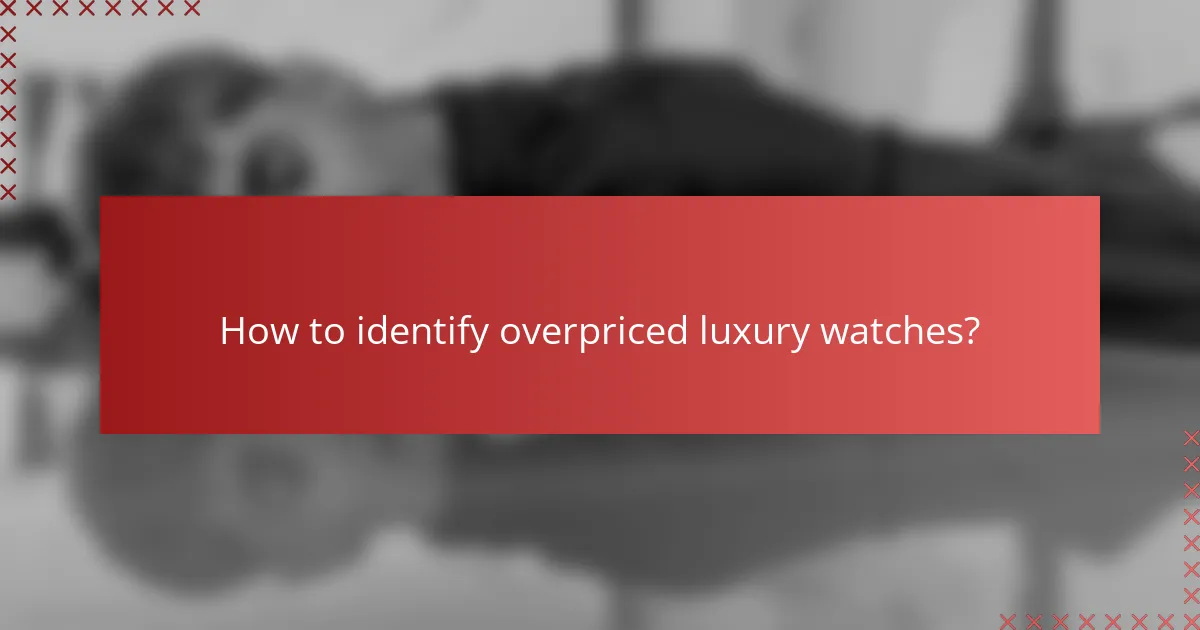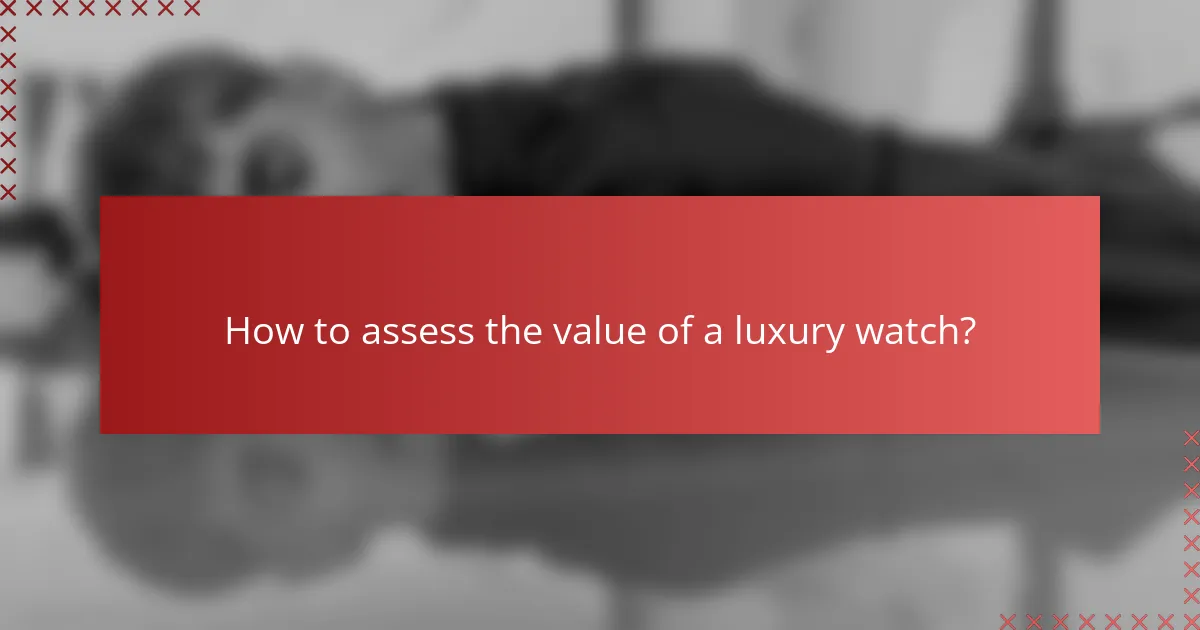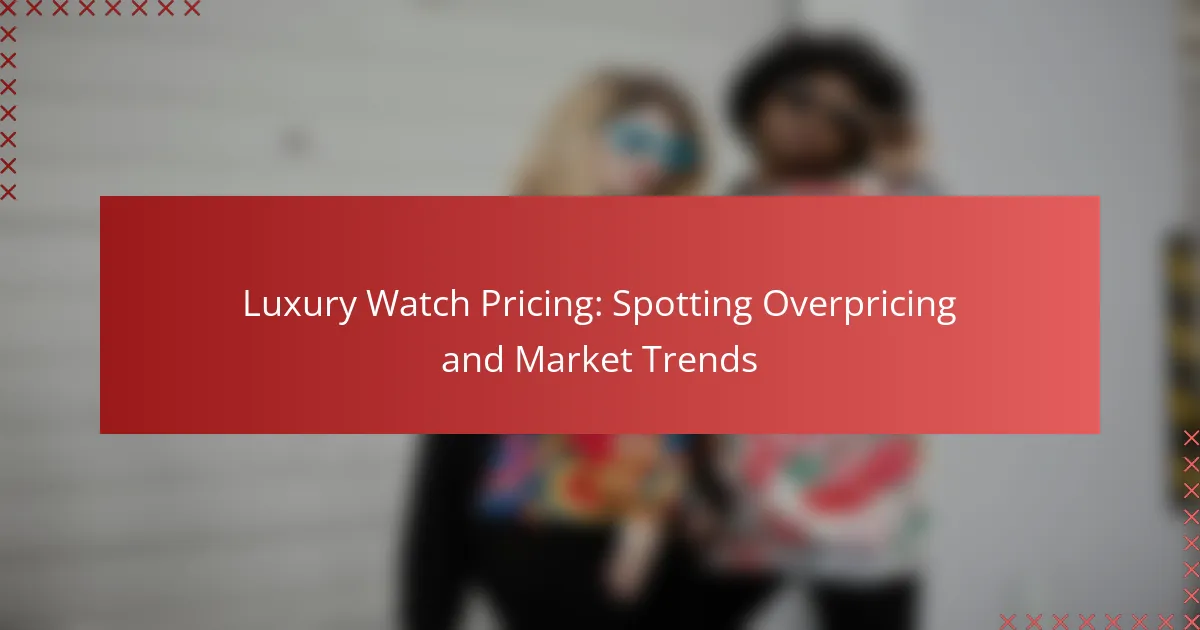Understanding luxury watch pricing is essential for discerning buyers looking to avoid overpaying for their timepieces. By analyzing market trends, brand reputation, and the condition of the watch, consumers can make informed decisions in a market influenced by shifting consumer preferences and economic factors.

How to identify overpriced luxury watches?
To identify overpriced luxury watches, compare their prices against market trends, evaluate brand reputation, and verify the watch’s condition and authenticity. Understanding these factors can help you avoid paying more than necessary for a luxury timepiece.
Market value comparison
Start by researching the current market value of the luxury watch you are interested in. Websites like Chrono24 and WatchBox provide listings that can help you gauge average prices for specific models. Look for price ranges that reflect recent sales to determine if a seller’s asking price is reasonable.
Consider factors like the watch’s age, rarity, and demand. Limited editions or discontinued models may command higher prices, while more common pieces should be priced lower. Always cross-reference multiple sources to ensure an accurate market value assessment.
Brand reputation analysis
The brand of the luxury watch significantly influences its pricing. Renowned brands like Rolex, Patek Philippe, and Audemars Piguet typically maintain higher resale values due to their prestige and craftsmanship. Research the brand’s history and reputation to understand its standing in the luxury market.
Be cautious of lesser-known brands that may price their watches similarly to established luxury names. These watches might not hold their value over time, making them potentially overpriced. Look for customer reviews and expert opinions to gauge the brand’s reliability and desirability.
Condition and authenticity verification
Assessing the condition of a luxury watch is crucial in determining its worth. Check for signs of wear, scratches, or damage, as these factors can significantly affect the price. A well-maintained watch with original parts will typically be valued higher than one that has been modified or poorly cared for.
Authenticity is paramount when buying luxury watches. Request documentation, such as original purchase receipts and certificates of authenticity, to confirm the watch’s legitimacy. If possible, have the watch inspected by a professional to ensure it is genuine, as counterfeit watches can be deceptively priced.

What are the current market trends for luxury watches?
The luxury watch market is currently experiencing significant shifts, driven by changing consumer preferences and economic conditions. Key trends include a surge in demand for vintage models, the influence of economic factors on pricing, and the growing popularity of limited edition releases.
Rising demand for vintage models
Vintage luxury watches are increasingly sought after, often fetching prices that exceed their original retail value. Collectors and enthusiasts are drawn to the unique history and craftsmanship of these timepieces, making them a desirable investment.
Brands like Rolex, Patek Philippe, and Omega are particularly popular in the vintage market, with certain models appreciating significantly over time. When considering a vintage purchase, it’s essential to verify authenticity and condition, as these factors greatly influence value.
Impact of economic factors
The luxury watch market is not immune to broader economic trends, such as inflation and changes in disposable income. Economic downturns can lead to decreased demand, while periods of economic growth often see increased spending on high-end timepieces.
Additionally, currency fluctuations can affect pricing in different markets. For instance, a strong Euro may make luxury watches more expensive for buyers in the United States, impacting international sales and pricing strategies.
Popularity of limited editions
Limited edition luxury watches have gained immense popularity, as they often combine exclusivity with unique design elements. Brands frequently release these models to create buzz and attract collectors, leading to rapid sell-outs and increased resale values.
When investing in limited editions, consider factors such as the brand’s reputation, the number of pieces produced, and market demand. These watches can serve as both a status symbol and a potential financial asset, but careful research is essential to avoid overpaying.

Which luxury watch brands are known for overpricing?
Several luxury watch brands are often cited for their high pricing, which can sometimes exceed the intrinsic value of the timepieces. Brands like Rolex, Patek Philippe, and Cartier are frequently discussed in this context due to their premium pricing strategies and market positioning.
Rolex pricing strategies
Rolex employs a unique pricing strategy that combines brand prestige with limited availability. Their watches are often priced significantly higher than similar models from other brands, reflecting their status as a symbol of success.
When purchasing a Rolex, buyers should be aware that prices can vary widely based on model, condition, and market demand. New models typically start in the low thousands of USD, while rare vintage pieces can command prices in the tens of thousands or more.
Patek Philippe market positioning
Patek Philippe is known for its exceptional craftsmanship and exclusivity, which justifies its high price tags. The brand often releases limited editions, creating a sense of urgency and desirability among collectors.
Prices for Patek Philippe watches generally start in the mid-thousands of USD and can escalate to several million for rare models. Buyers should consider the brand’s reputation for value retention, as many Patek Philippe watches appreciate over time.
Cartier luxury perception
Cartier’s pricing reflects its long-standing reputation as a luxury brand, often associated with elegance and sophistication. Their watches are marketed not just as timepieces but as fashion statements, which can lead to inflated prices.
Cartier watches typically range from a few thousand to tens of thousands of USD, depending on the model and materials used. When evaluating a Cartier watch, potential buyers should assess both the design and the craftsmanship to determine if the price aligns with their expectations for luxury.

How to negotiate luxury watch prices?
Negotiating luxury watch prices involves research, relationship-building, and timing. Understanding the market and establishing a connection with sellers can significantly enhance your bargaining power.
Researching comparable sales
Start by researching recent sales of similar luxury watches to gauge their market value. Websites like Chrono24 and WatchBox provide valuable insights into pricing trends and can help you identify fair price ranges.
Look for watches with similar models, conditions, and included accessories. This will give you a solid foundation for your negotiation, allowing you to present data-backed arguments to the seller.
Building rapport with sellers
Establishing a good relationship with the seller can make a significant difference in negotiations. Approach them with respect and genuine interest in the watch, which can lead to a more favorable negotiation atmosphere.
Engage in conversation about the watch’s history or features, and share your own experiences with luxury watches. This personal connection may encourage the seller to be more flexible with their pricing.
Timing your purchase
Timing can greatly influence the price you pay for a luxury watch. Consider purchasing during off-peak seasons, such as after the holiday rush, when sellers may be more willing to negotiate.
Additionally, keep an eye on market trends and new releases. If a new model is about to launch, prices for older models may drop, providing an opportunity for better deals.

What factors influence luxury watch pricing?
Luxury watch pricing is influenced by a combination of materials, craftsmanship, brand heritage, and market dynamics. Understanding these factors can help buyers identify fair prices and avoid overpricing.
Materials and craftsmanship
The quality of materials and the level of craftsmanship significantly impact luxury watch pricing. High-end watches often use precious metals like gold or platinum, along with high-grade ceramics and sapphire crystals, which can drive costs up. Additionally, intricate movements and hand-finished details contribute to the overall value.
For example, a watch featuring a Swiss-made automatic movement typically commands a higher price than one with a quartz movement. Buyers should assess the materials used and the craftsmanship involved to gauge whether the price reflects the quality.
Brand heritage and prestige
Brand heritage plays a crucial role in luxury watch pricing. Established brands with a long history, such as Rolex or Patek Philippe, often carry a premium due to their reputation for quality and exclusivity. These brands have built trust over decades, which can justify higher price tags.
When considering a purchase, it’s essential to research the brand’s history and its standing in the luxury market. A lesser-known brand may offer similar quality at a lower price, but it might not hold its value over time like a more prestigious name.
Market demand and supply dynamics
Market demand and supply dynamics are key determinants of luxury watch pricing. Limited editions or highly sought-after models often see prices soar due to scarcity. Conversely, if a brand produces too many units, prices may stabilize or even drop.
Buyers should monitor market trends and demand for specific models. Tools like auction results and resale platforms can provide insights into current market values. Understanding these dynamics can help buyers make informed decisions and avoid overpaying for a watch.

How to assess the value of a luxury watch?
Assessing the value of a luxury watch involves evaluating its brand, condition, rarity, and market demand. Understanding these factors can help you identify whether a watch is fairly priced or overpriced in the current market.
Expert appraisals
Expert appraisals are conducted by certified professionals who specialize in luxury watches. They assess various attributes such as brand reputation, craftsmanship, and condition, providing a detailed report that can help determine a watch’s market value.
When seeking an appraisal, look for professionals affiliated with recognized organizations, as their credentials can enhance the credibility of the valuation. Expect to pay a fee for this service, which can range from a few hundred to over a thousand dollars depending on the watch’s complexity and the appraiser’s expertise.
Online valuation tools
Online valuation tools offer a convenient way to estimate the value of a luxury watch based on various parameters. Websites often allow users to input details like brand, model, age, and condition to generate an estimated market value.
While these tools can provide a quick reference, they may not always reflect the latest market trends or specific nuances of individual watches. Use them as a starting point but consider corroborating with expert opinions for a more accurate assessment.
Historical sales data
Analyzing historical sales data can reveal trends in luxury watch pricing and help you gauge current market values. Platforms like auction houses and online marketplaces often publish past sale prices, which can serve as benchmarks for similar models.
When reviewing this data, pay attention to factors such as the watch’s condition, rarity, and any unique features that may affect its value. This information can help you make informed decisions when buying or selling luxury watches, ensuring you avoid overpricing pitfalls.
